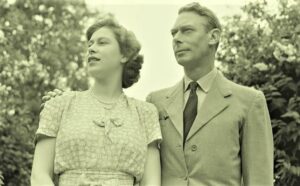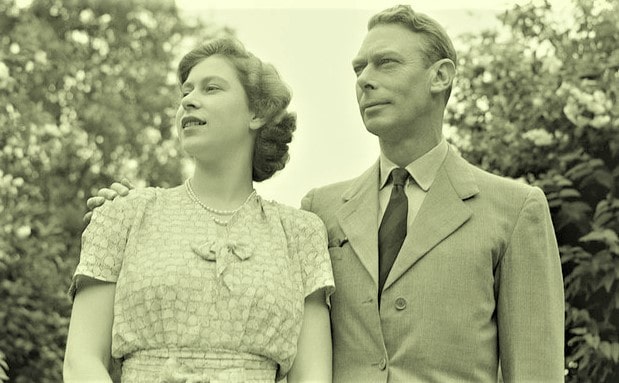
George VI of the United Kingdom (Born as Albert Frederick Arthur George; on December 14, 1895, in York Cottage, United Kingdom – Died on February 6, 1952, Sandringham Estate, United Kingdom) was King of the United Kingdom and its overseas dominions from November to December of 1936 until his death.
He was the last emperor of India (until August 14, 1947), and the first head of the Commonwealth of Nations. As the second son of King George V and Queen Mary was not expected to inherit the throne after the death of his father.
In 1909 he began his career in the British Royal Navy, taking part, as an officer of the HMS Collingwood ship, in the Battle of Jutland during the First World War. He married Lady Isabel Bowes-Lyon in 1923, a marriage that had two daughters, Isabel (who succeeded her as Queen Elizabeth II) and margarita Rosa.
George VI’s elder brother, Edward VIII, ascended the throne after his father’s death in 1936. However, less than a year later, he announced his intentions to marry a commoner American, Wallis Simpson.
The British Prime Minister Stanley Baldwin warned the king that, for political and religious reasons, he could not remain king should marry Simpson, who had divorced twice. Edward VIII abdicated the British Crown on December 11, 1936, to be able to marry Simpson.
Then, unexpectedly, George ascended the throne as the third monarch of the House of Windsor. The loss of power by the United Kingdom in the Irish Free State and the war against Nazi Germany and its allies marked his reign.
In addition to the independence of India and Pakistan in 1947 and the founding of the Republic of Ireland in 1949, the reign of George VI saw the acceleration of the disintegration of the Empire and its transition to the Commonwealth of Nations.
George VI’s state of health gradually worsened. He died at the age of 56, on February 6, 1952while sleeping, due to coronary thrombosis. Upon his death, his daughter Elizabeth succeeded him on the British throne.
Quick Facts: George VI
- Born: 14 December 1895, York Cottage, United Kingdom
- Known For: King of the United Kingdom and its overseas dominions
- Also known As: Albert Frederick Arthur George
- Parents: (Father – George V), (Mother – Mary of Teck)
- Dynasty: Windsor
- Period: 1936 – 1952
- Predecessor: Edward VIII
- Successor: Elizabeth II
- Spouse: Queen Elizabeth The Queen Mother
- Children: Queen Elizabeth II, Princess Margaret, Countess of Snowdon
- Died: 6 February 1952, Sandringham Estate, United Kingdom
- Quotes: “It is not the walls that make the city, but the people who live within them. The walls of London may be battered, but the spirit of the Londoner stands resolute and undismayed.”
The Early Life of George VI
George VI was born in York Cottage, on the Sandringham property in Norfolk, during the reign of his great-grandmother, Queen Victoria. His father was Prince George, Duke of York (later George V), 1 the second and only surviving male child of the Princes of Wales (later King Edward VII and Queen Alexandra).
Her mother was the Duchess of York (later Queen Mary), the Duke’s eldest and only daughter, and the Duchess of Teck. George VI was born on 14 December of 1895, 1 the same day that his great – grandfather Albert, Prince Consort had died in 1861.
Unsure of how Queen Victoria, widow of Prince Albert, would take the news of the birth, the Prince of Wales wrote to the Duke of York that the Queen “would be rather distressed.” 10 Two days later the prince wrote again to Duke saying, “I’m sure she would be satisfied if you only resolve to call Alberto.”
Queen Victoria was reassured to learn of the proposal to call baby Albert and wrote to the Duke of York: “I am eager to see the new baby, born on such a sad day but quite dear to me, especially if he is called that mode, a name that is synonymous with everything great and good.
Consequently, he was baptized three months later as “Albert Frederick Arthur George”, in the Church of Saint Mary Magdalene near Sandringham, although his family informally gave him the name “Bertie”.
However, his maternal grandmother, the Duchess of Teck, did not like the first name given to the baby (Alberto) and prophetically wrote that he hoped that his last name (George) “could impersonate the least graceful”.
Military Career
In 1909 Albert entered the Royal Naval College in Osborne. In 1911, he arrived in the last of his class during the final exam but joined the Royal Naval College of Dartmouth. When Edward VII died in 1910, Albert’s father became king under the name of George V. Edward became Prince of Wales and Albert was now second in succession.
Albert spent the first six months of 1913 aboard the training ship HMS Cumberland in the Caribbean and on the East Coast of Canada. He then embarked as a midshipman on HMS Collingwood on September 15, 1913, and spent three months in the Mediterranean.
His fellow officers gave him the nickname “Mr. Johnson”. A year later, he began his service during the First World War. He received a military citation for his role as a turret officer aboard HMS Collingwood during the Battle of Jutland which was the main naval engagement of the war.
He did not take part in other fights, mainly because of health problems caused by a peptic ulcer for which he was operated in November 1917. In February 1918, he was appointed an officer at the Royal Naval Air Service training airbase at Cranwell.
With the creation of the Royal Air Force (RAF) two months later and the transfer of the Cranwell base from the navy to the air force, Albert joined the Royal Air Force. He was appointed commanding officer at Cranwell and remained there until August 1918.
He was the first member of the royal family to obtain his pilotage certificate. In t he last weeks of the war, he served on the staff of the RAF strategic bombing uniting Nancy. After the dissolution of the unit at the end of the war, he spent two months on the continent before returning to Britain.

